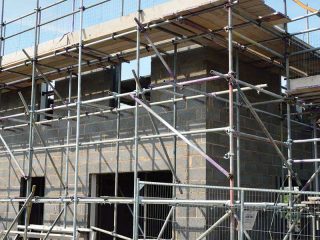Project management is the management of people, time, money and quality by an individual or a team to ensure the efficient commencement, progress and conclusion of a project. All these elements apply to construction projects regardless of their size. Eddie Weir, principal partner of Architectural Design Partnership and CIAT Northern Ireland Regional Chairman, shares his thoughts on the pros and cons of the routes open to you.
Statutory approvals, check. Financing options, check. Now who’s going to manage the project? Tempting as it may be to appoint yourself, if you’re going for a mortgage know that your lender may require that you appoint a professional to issue a “Professional Consultant’s Certificate”. This certificate will require a degree of contract administration and site supervision. The Council of Mortgage Lenders, which represents 97 per cent of UK mortgage lending, provides further advice on the topic on cml.org.uk. In this context it’s important to note many professionals are uncomfortable in certifying construction projects where the construction works are spilt up in a piecemeal manner (with no overarching contractors’ warranty). This is often partly why in the case of a home building or home improvement project, the role of project manager is commonly handed over to a builder or a professional. The project management elements for ROI are outlined here ; there are different things to keep on top of on site and off site. Self-builder as project manager The self-builder directly employs a main contractor (or series of sub-contractors) to run the building site on a day-to-day basis. This will usually involve the main contractor being responsible for organising a smooth flow of labour onto the site when necessary and paying them directly. Also known as the direct labour approach. Pros:- You are the boss. Everything that happens comes under your control and you should get exactly what you want.
- You control the programme, which can be tailored to match your design development — the need to know the tile colour is less critical when the foundations are being dug.
- Direct management of the work can give you greater flexibility. You can accelerate or slow down the works to suit your individual requirements — if cash flow is putting pressure on, slowing slightly or delaying the work for a month may well ease this.
- You know you are getting best value when you procure, because the process is open and transparent.
- You will save on overheads by eliminating the main contractor.
- The final fit and finish and specification is as detailed as you want it to be — as the project manager, you can look at the design, the drawings and the specification, and add as much additional detail, samples, mood boards and technical support as you feel is necessary to avoid any miscommunication with the trades / contractors doing the work.
- Are you ready for the level of input it requires? The time required to manage the scheme is always more than anyone planned — your build will require you to be on site each day (or at least a fair part of each day), and your evenings will be spent scheduling, procuring and planning.
- The emotional investment required is immense — the nature of co-ordinating trades, supplies, deliveries and site logistics is challenging, and is demanding even for those who have done it for years.
- Do you have the right temperament for the role? If you can’t bear the thought of conflict with sometimes irate tradespeople, maybe you need to think again. If you know your admin and paperwork skills are poor, you may need additional resources to help you. You need to be sure of your contacts and links to the industry — how will you find bricklayers? Do you know a reliable electrician? Recommendation is useful, but research and more research are vital.
- You are funding the scheme, and are responsible for each payment to each subcontractor and supplier individually — you will need to set up a payment ledger to manage this, along with the hassle of individual valuation and measurement of works done every month/week.
- The lack of credit line facility may require greater cash flow consideration when selfmanaging. You will need to make upfront payments for goods and fittings, and in many cases the availability of trade discounts will be less than for an established contractor, subsequently negating some of the savings achieved by managing the works yourself.
- You will need to carry insurance for the site — individual trades will hold their own insurances, but these will normally be limited to the value of the works they are carrying out.
- Self-management requires a level of technical knowledge to ensure you understand the implications of the information you are dealing with. You also need to be confident that you can appreciate the subcontractors’ requirements, information and demands, and balance this with the legislative and practical demands of the wider scheme.
- Health and safety on site will become your responsibility overall — the site is in your control.
- Logistics will require planning — welfare facilities, craneage, water, electricity, etc.
Main contractor as project manager
As the client you contract a builder to carry out the work and manage the process for you. Pros:- A good contractor will have experience and insight into the build and pre-empt many issues before they arise
- They’re experienced in programming and procurement scheduling.
- They are responsible for health and safety on site.
- They’ll carry appropriate insurances for the works but make sure to check these are in place.
- Payments and cash flow of the trades are the contractor’s responsibility.
- The contractor’s credit lines ensure efficient cash flow.
- The range of contacts and sources of materials is extensive and generally very reliable.
- The use of a fixed-price contract gives an element of cost certainty, which helps both your planning, and your mortgage lender’s level of comfort.
- Logistics and day-to-day running should be efficient and timely, and the site left clean and safe each day as part of the contractor’s working practices.
- You make one payment each agreed period (usually monthly) to the contractor, which cuts down the complexity considerably.
- Added cost: the contractor will have built in a level of profit into your contract price.
- The scheduling and programming is out of your control.
- The solvency of the contractor is essential to the smooth running of the site
- The contractor may make assumptions in the event that you are not around — your specification documentation must be as comprehensive as possible to avoid unexpected issues.
- Your control over the supply chain stops with the main contractor, which is less hassle for you, but more reliance is then placed on your documentation and specification to ensure you get what you think you are getting.
- If you delay or stop the work for whatever reason, the contract may well contain provision for payment of loss of profit to the contractor — generally once the contract starts, it is financially vital that it finishes!
- The feeling of empowerment you get from managing the process is lost when a main contractor is engaged — equally, the feeling of despair when it is stressful is lost too!
Professional as project manager
An in-between solution that sees a professional (a project manager by profession or a building designer) act on your behalf for a fee that’s usually less than the profit the builder will take if he takes on the role.Health and safety
Whatever your role in construction, the Construction (Design and Management) Regulations (Northern Ireland) 2016 aims to improve health and safety in the industry by helping you to:- Sensibly plan the work so the risks involved are managed from start to finish.
- Have the right people for the right job at the right time.
- Co-operate and coordinate your work with others.
- Have the right information about the risks and how they are being managed.
- Communicate this information effectively to those who need to know.
- Consult and engage with workers about the risks and how they are being managed.
- Appoint a Principal Designer and Principal Contractor.
- Ensure there are arrangements in place for managing and organising the project.
- Allow adequate time.
- Ensure that a Pre-Construction Phase Plan is provided (PD designer).
- Ensure that a Construction Phase Plan is in place (PC contractor).
- Ensure a Health & Safety File is prepared and make it available to anyone who maintains or alters the building in the future.
SelfBuild Ireland has just launched a range of build cost calculators powered by online budgeting tool ProntoCalc. The Build Cost Calculator gives you a rough idea of how much your project will cost, contractor led. It’s free, quick and easy. You can use it below: div>










